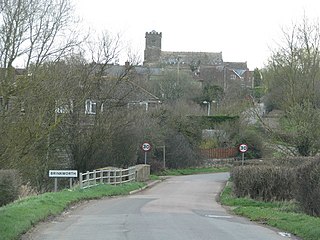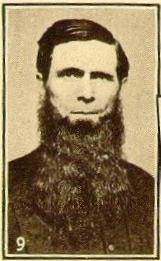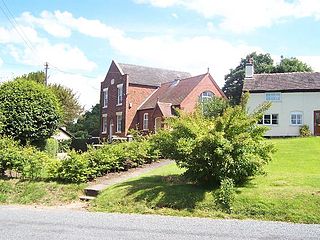
Rev. Richard Jukes (1804–1867) was a popular Primitive Methodist minister and hymn writer. This article provides a brief biography, and a summary of his work as a popular minister and hymn writer during the first half-century of Primitive Methodism.

Rev. Richard Jukes (1804–1867) was a popular Primitive Methodist minister and hymn writer. This article provides a brief biography, and a summary of his work as a popular minister and hymn writer during the first half-century of Primitive Methodism.
Richard Jukes was born on 9 October 1804 at Goathill, and died 10 August 1869. He served as a Primitive Methodist minister from 1827 to 1859. Jukes married Phoebe Pardoe in 1825, and later, widowed, he married Charlotte. [1]

Goathill is a hamlet and civil parish in the county of Dorset in England, situated in the West Dorset district a couple of miles east of the town of Sherborne. It lies very close to the county boundary however, and for much of its history lay instead within the neighbouring county of Somerset, and has been described as being "just in Dorset by a nanny-goat's whisker". It remains part of the diocese of Bath and Wells.

Brinkworth is a village and civil parish in northern Wiltshire, England. The village lies between Royal Wootton Bassett and Malmesbury, about 1 mile (1.6 km) north of the M4 motorway and 9 miles (14 km) west of Swindon.

Motcombe is a village and civil parish in the county of Dorset, England. It lies in the North Dorset administrative district, about 2 miles (3.2 km) north of the town of Shaftesbury. It is sited on Kimmeridge clay soil beneath hills at the edge of the Blackmore Vale. The parish is one of the largest in Dorset. In the 2011 census the parish had 611 dwellings, 564 households and a population of 1,474.

Pillowell is a small village in Gloucestershire, England, on the south-eastern edge of the Forest of Dean.
While Richard Jukes left his mark in Kendall's history as a hymn writer, his work as a minister was widely appreciated. It is noteworthy that, after a number of appointments where he would have been the junior, Jukes was appointed to three of the most significant Circuits of that time. Tunstall, Staffordshire was the place of origin of Primitive Methodism and Ramsor had been almost as significant. Darlaston was very much the leading light in the Black Country. [3] Jukes spent a large part of his active ministry in The Black Country and retired there.

Tunstall is a constituent town in the area of Stoke-on-Trent, Staffordshire, England. It was one of the original six towns that federated to form the city. Tunstall is the most northern, and fourth largest town of the Potteries. It is situated in the very northwest of the city borough, with its north and west boundaries being the city limit. It stands on a ridge of land between Fowlea Brook to the west and Scotia Brook to the east, surrounded by old tile making and brick making sites, some of which date back to the Middle Ages.

Darlaston is a suburban area of Walsall in the Metropolitan Borough of Walsall in the West Midlands of England. It is also close to Wednesbury which is a mile away.

The Black Country is an area of the West Midlands, England, west of Birmingham and commonly refers to a region covering most of the four Metropolitan Boroughs of Dudley, Sandwell, Walsall and Wolverhampton. During the Industrial Revolution, it became one of the most industrialised parts of Britain with coal mines, coking, iron foundries, glass factories, brickworks and steel mills producing a high level of air pollution.
Hugh Bourne reveals a special interest in Ramsor in his writings in The Primitive Methodist Magazine, through the way he illustrates articles with anecdotes of Ramsor people. [4]

Hugh Bourne along with William Clowes was the joint founder of Primitive Methodism, the largest offshoot of Wesleyan Methodism and, in the mid nineteenth century, an influential Protestant Christian movement in its own right.
The Primitive Methodist Magazine was the monthly magazine of the Primitive Methodist Church in Britain, spanning just over a century. It was started in 1821. From 1821, the Magazine was edited by Hugh Bourne, who printed the magazine at Bemersley Farm about 2 miles from Mow Cop. Production was moved to London in 1843 when John Flesher became the Editor. One of the more famous editors was H B Kendall, the writer of three major histories of Primitive Methodism.
Holliday Bickerstaffe Kendall says of Richard Jukes, “although he was a prolific and popular hymn-writer of his day, is in some danger of being forgotten.” [5] The major biography of Jukes has the title "Poet of a Million", reflecting this claim to fame. Kendall also says, “Jukes’ hymns have been sung from one end of the Connexion to the other, by tramps in the street and Christians in the chapels; and the late Dr. Massie says, the hymn entitled “What’s the news,” &co., has been sung and repeated in the great Revival in Ireland.” [6]

Holliday Bickerstaff(e) Kendall, was a Primitive Methodist Minister, President of the Conference (1901). Editor, Author and Historian. Kendall wrote three separate histories of the Primitive Methodist Church which became to be regarded as the difinitive history of the Church.

Ireland is an island in the North Atlantic. It is separated from Great Britain to its east by the North Channel, the Irish Sea, and St George's Channel. Ireland is the second-largest island of the British Isles, the third-largest in Europe, and the twentieth-largest on Earth.
Part of the genius of Richard Jukes the hymn writer was his ability (shared with other Primitive Methodists including Henry Higginson ) to use the best popular melodies of his time. A contemporary account by a Jonathan Ireland in Lancashire will be useful to researchers into 19th-century hymns.
Before the Primitive Methodists came to this city (Manchester), and for some time after, it was very common to hear lewd or ribald songs sung in the streets, especially on the Lord’s day. But our movements drove them away by putting something better in their place. We used to pick up the most effective tunes we heard, and put them to our hymns; and at our camp meetings people, chiefly young ones, used to run up to hear us, thinking we were singing a favourite song. But they were disappointed therein; nevertheless, they were arrested and often charmed by the hymn, which at times went with power to their hearts. And so the words of the hymn put aside the words of the song. It will show the utility of singing lively hymns in the streets; yea, more particularly, it will show the use to society in general of our hymn singing in the streets, if I here relate a fact which was told me by a friend on whose veracity and accuracy I can place reliance. He said : “I was one day in a hair-dresser’s shop in a country village, when a man came in to be shaved, having a handful of printed hymns, which he had been singing and selling in the streets. I entered into conversation with him, in course of which he said : “Your Jukes has been a good friend to us street-singers; I have sung lots of his hymns, and made many a bright shilling thereby. People generally would rather hear a nice hymn sung, than a foolish song, – and his hymns are full of sympathy and life. Depend on it, the singing of hymns in the streets has done a good deal of good ; for children stand to listen to us, and they get hold of a few lines, or of the chorus ; and with the tune, or as much of it as they can think of, they run home, and for days they sing it in their homes, and their mothers and sisters get hold of it, and in this way, I maintain, our hymn-singing is of more use than many folks think. I shall always think well of Jukes,” concluded the man. [7]
Much of Jukes’ output seems to have been published in special collections. Unfortunately, his writing was not used in many hymn books, and the only hymn to have survived in common use is “Christ for me”. Even this was not used in the 1882 Primitive Methodist Hymnal, but only in the 1911 Supplement. As an example of Jukes' hymns, here is the version used in the 1911 Supplement. Other verses have been sung.
My heart is fixed eternal God,
Fixed on Thee : Fixed on Thee :
And my immortal choice is made :
Christ for me.
He is my Prophet, Priest and King,
Who did for me salvation bring ;
And while I’ve breath I mean to sing :
Christ for me. Christ for me.
2 In Him I see the Godhead shine ;
Christ for me. Christ for me.
He is the Majesty Divine ;
Christ for me.
The Father’s well-beloved Son,
Co-partner of His royal throne,
Who did for human guilt atone ;
Christ for me. Christ for me.
3 Let others boast their heaps of gold;
Christ for me. Christ for me.
His riches never can be told ;
Christ for me.
Your gold will waste and wear away,
Your honours perish in a day ;
My portion never can decay ;
Christ for me. Christ for me.
4 In pining sickness or in health,
Christ for me. Christ for me.
In deepest poverty or wealth,
Christ for me.
And in that all-important day,
When I the summons must obey,
And pass from this dark world away,
Christ for me. Christ for me.
R. Jukes [8]

A hymn is a type of song, usually religious, specifically written for the purpose of adoration or prayer, and typically addressed to a deity or deities, or to a prominent figure or personification. The word hymn derives from Greek ὕμνος (hymnos), which means "a song of praise". A writer of hymns is known as a hymnodist. The singing or composition of hymns is called hymnody. Collections of hymns are known as hymnals or hymn books. Hymns may or may not include instrumental accompaniment.
The Finlandia hymn refers to a serene hymn-like section of the patriotic symphonic poem Finlandia, written in 1899 and 1900 by the Finnish composer Jean Sibelius. It was later re-worked by the composer into a stand-alone piece.
The Primitive Methodist Church is a body of Holiness Christians within the Methodist tradition, which began in England in the early 19th century, with the influence of American evangelist Lorenzo Dow (1777–1834).

Primitive Methodism was a major movement in English Methodism from about 1810 until the Methodist Union in 1932. The denomination emerged from a revival at Mow Cop in Staffordshire. "Primitive" meant "simple" or "relating to an original stage"; the Primitive Methodists saw themselves as practising a purer form of Christianity, closer to the earliest Methodists.

The Wesley Covenant Service was adapted by John Wesley, the founder of Methodism, for use in services for the Renewal of the believer's Covenant with God. In his Short history of the people called Methodists, Wesley describes the first covenant service; a similar account is to be found in his Journal of the time. Wesley says that the first service was held on Monday 11 August 1755, at the French church at Spitalfields in London, with 1800 people present. He reports that he "recited the tenor of the covenant proposed, in the words of that blessed man, Richard Alleine".

"Christ the Lord Is Risen Today" is a Christian hymn associated with Easter. Most of the stanzas were written by Charles Wesley, and the hymn appeared under the title "Hymn for Easter Day" in Hymns and Sacred Poems by Charles and John Wesley in 1739. The hymn eventually became well known for its repetitive "Alleluias" sung after each line, which were added by an unknown author to fit the commonly used hymn tune of "Easter Day". It remains a traditional processional hymn on Easter Sunday.

"Rock of Ages" is a popular Christian hymn written by the Reverend Augustus Toplady in 1763 and first published in The Gospel Magazine in 1775.

Cwm Rhondda, taken from the Welsh name for the Rhondda Valley, is a popular hymn tune written by John Hughes.

"Nearer, My God, to Thee" is a 19th-century Christian hymn by Sarah Flower Adams, which retells the story of Jacob's dream. Genesis 28:11–12 can be translated as follows: "So he came to a certain place and stayed there all night, because the sun had set. And he took one of the stones of that place and put it at his head, and he lay down in that place to sleep. Then he dreamed, and behold, a ladder was set up on the earth, and its top reached to heaven; and there the angels of God were ascending and descending on it..."

Knowles Shaw was an American author and composer of gospel hymns.
Philip William Otterbein was a U.S. (German-born) clergyman. He was the founder of the United Brethren in Christ, a group that is a forerunner of today's United Methodist Church.

The tiny hamlet of Ramsor in North Staffordshire played a significant part in the origins of Primitive Methodism. Listed in the Domesday Book as Ramshorn, this ancient hamlet is a typical example of the depopulation of the countryside. Very little now remains of this village apart from a few farms and cottages. The Primitive Methodist Chapel is the only surviving public building.

"The Hymn of Joy" is a poem written by Henry van Dyke in 1907 with the intention of musically setting it to the famous "Ode to Joy" melody of the final movement of Ludwig van Beethoven's final symphony, Symphony No. 9.

Cradley Heath Baptist Church, also known as Four-ways Baptist Church, was the first Church of any denomination to build a chapel in Cradley Heath, West Midlands. The first meeting was in December 1833, in Granger's Lane. Later, land was bought near the Four-Ways end of the High Street, and a meeting place was built. The site was expanded, and two further buildings were built, the last in 1904.

Rev. George Cosens (1805–1881), is the "first reported West Indian minister to hold a pastorate in Britain." He originated from Jamaica, and lived most of his life in Britain having moved to London to study and joining the Primitive Methodists in his late teens. After working as a Primitive Methodist preacher, he joined the Baptists and from 1837 served as a minister in various Baptist churches. He died in working retirement in 1881. George Cosens married twice, Mary Burnet, 1830, and being widowed, Betsy Dancer in 1841. He is buried in the cemetery of Brierly Hill Baptist Church.

Englesea Brook Chapel and Museum is in the village of Englesea-Brook, Cheshire, England. Built in 1828, the chapel was one of the earliest chapels of the Primitive Methodist movement, and the Sunday school was added in 1914. Since 1986 it has been a museum of Primitive Methodism. The building is recorded in the National Heritage List for England as a designated Grade II listed building. In the chapel is a historic pipe organ. The museum contains artefacts relating to the movement, and arranges a changing programme of exhibitions and other events. In the graveyard near the museum is a monument to Hugh Bourne, founder of the movement.

"Lo! He Comes with Clouds Descending" is a hymn with a text by John Cennick (1718–1755) and Charles Wesley (1707–1788). Most commonly sung at Advent, the hymn derives its theological content from the Book of Revelation relating imagery of the Day of Judgment. Considered one of the "Great Four Anglican Hymns" in the 19th century, it is most commonly sung to the tune Helmsley, first published in 1763.